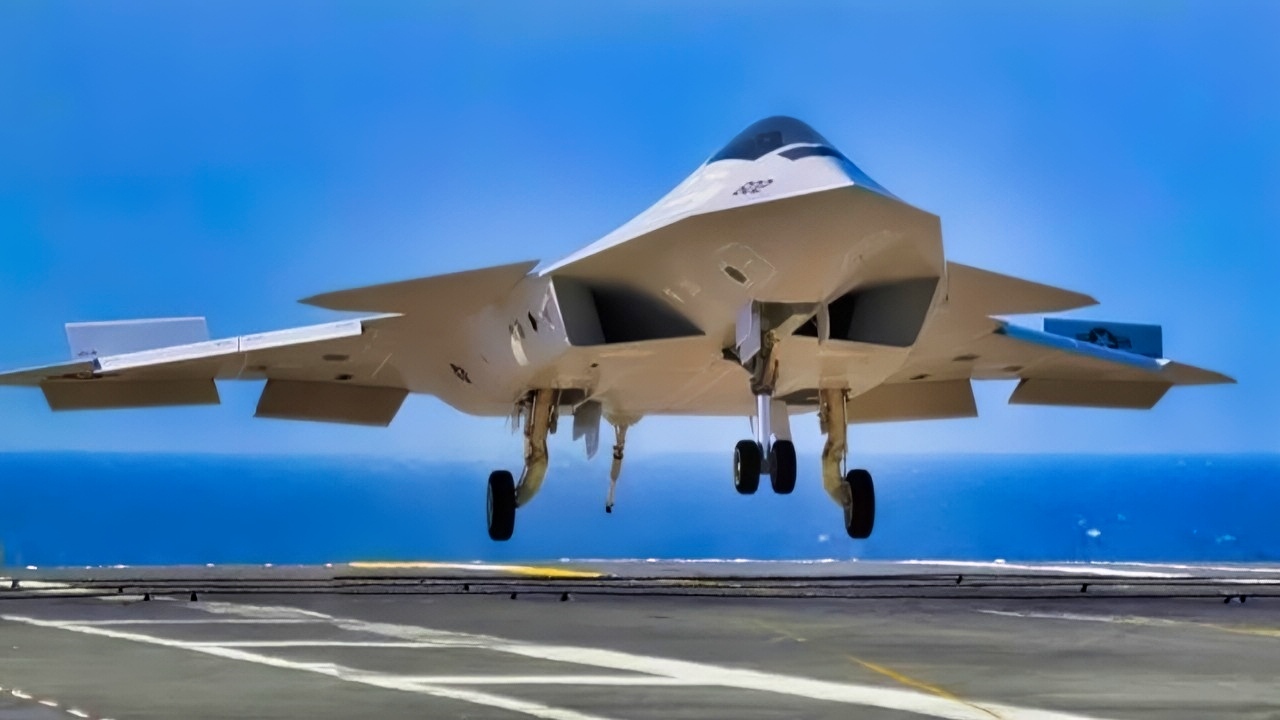Key Points and Summary – The Navy’s future air wing faces a capacity and range crunch: just 273 F-35Cs across a large carrier fleet, and Super Hornets already beyond intended service lives. Enter F/A-XX, a sixth-generation, carrier-launched stealth fighter aimed at restoring deterrence against China’s growing J-20 fleet, emerging J-35 carrier stealth jet, and rumored sixth-gen designs.
-Beyond stealth and sensors, the pivotal edge is range—potentially around 2,000 miles—allowing carriers to operate farther offshore with less tanker support while sustaining tempo over the Pacific’s distances.

Boeing NGAD F/A-XX Fighter Rendering. Image Credit: Boeing.
-With Boeing and Northrop Grumman competing and Congress weighing costs and fleet size, delaying F/A-XX risks ceding mass, reach, and initiative to the PLA.
Navy’s 6th-Gen F/A-XX: The Only Way to Deter China’s J-20 and J-35?
The United States Navy plans to acquire only 273 F-35Cs spread across a large carrier fleet, and the F/A-18 Super Hornet has already flown thousands of flight hours beyond its expected service life.
Therefore, not funding, building, and acquiring a sizable fleet of F/A-XX 6th-generation carrier-launched stealth fighters could imperil the US Navy’s ability to deter China in the Pacific for several key reasons.
Industry powerhouse vendors Northrop Grumman and Boeing are competing to build the new jet. Congress is deliberating funding for the aircraft, and the Pentagon hopes to surge into the future with a new generation of carrier-launched, stealthy 6th-gen fighter jets.
Many key variables are hanging in the balance for the F/A-XX’s future, including questions of stealth, range, fleet size, service life, and, perhaps most significant, the threat equation.

F/A-XX Fighter from Boeing. Image Credit: Boeing.
Chinese J-20 Threat
One initial question can be simply understood in terms of the issue of mass, meaning the US Navy would likely be at a significant fleet-size deficit compared to China in the event of a conflict in the Pacific.
China is now believed to operate as many as 300 J-20 5th-generation fighters, a sizable available force positioned to defend China’s coastal waters up to several hundred miles offshore.
Although it is a land-launched fighter, China cannot launch the J-20 from a carrier.
Still, the fighter can certainly reach the waters around Taiwan and extend several hundred miles offshore toward the first island chain. Hundreds of J-20s could form a perimeter formation in a semi-circle off the Chinese coast, positioned to defend a sphere of PLA influence and security.
F/A-18 Future
The question of mass also significantly pertains to the F/A-18 because the classic Hornet and Super Hornet aircraft have already flown thousands of miles beyond their expected service life.
A special US Navy Service Life Extension Plan reinforced the F/A-18 airframe, added new sensing and avionics, conformal fuel tanks, digital cockpit displays, and specially engineered carrier-landing software, known as “magic carpet.”

F/A-XX Fighter. Image Credit: Creative Commons.
The F/A-18s have also been equipped with Infrared Search & Track targeting technology, designed for high-fidelity imaging and the ability to operate in an electronic warfare (EW) jamming environment. Despite these many innovations and successful upgrades, the F/A-18 has exceeded its capacity and can no longer fly for much longer.
The Chinese threat equation extends far beyond the J-20, as well, given the rapid emergence of the now-operational carrier-launched J-35 stealthy 5th-generation aircraft.
Previously known as the J-31, the carrier-launched J-35 5th-generation stealth jet is already flying from PLA Navy carriers.
Given China’s well-known civil-military fusion in weapons and platform production capacity, a sizable fleet of J-35s is expected to arrive in the coming years.
The J-35 resembles the F-35C and may rival its capabilities, depending on the performance of its computing, sensing, fire control, weapons, and agility.
Chinese 6th-Gen
Perhaps of even greater concern to the Pentagon, the PLA appears to be accelerating the development of two new, previously unseen 6th-generation aircraft: the Shenyang J-50 and the triple-engine stealth fighter-bomber hybrid Shenyang J-36.

F/A-XX U.S. Navy Fighter. Image Credit: Creative Commons.

F/A-XX U.S. Navy Fighter. Image Credit: Creative Commons.
Many details and specifics related to these 6th-gen aircraft are not yet available; however, it is entirely conceivable that one or both of them could be carrier-launched.
Range Deficit
Early speculation and some reporting related to the F-47 and F/A-XX indicate that the Pentagon’s emerging 6th-generation stealth fighters are being built with the ability to fly much longer ranges than existing 5th-gen aircraft.
This is of great tactical relevance in the huge expanse of the Pacific, as the Pentagon has indicated that the F-47 will likely operate with a range of 2,000 miles.
Should the F/A-XX operate with a similar range, it would introduce new tactical and strategic considerations as it is considerably longer than an F-35C’s overall combat range of 1,300 nautical miles.
This means the F/A-XX could strike from greater distances, operate with more dwell time, and attack from carriers further offshore without needing a refueler.
About the Author: Kris Osborn, Warrior Maven President
Kris Osborn is the President of Warrior Maven – Center for Military Modernization. Osborn previously served at the Pentagon as a highly qualified expert in the Office of the Assistant Secretary of the Army—Acquisition, Logistics & Technology. Osborn has also worked as an anchor and on-air military specialist at national TV networks. He has appeared as a guest military expert on Fox News, MSNBC, The Military Channel, and The History Channel. He also has a Masters Degree in Comparative Literature from Columbia University.
More Military
Russia’s ‘New’ Su-75 Checkmate Stealth Fighter Could Soon Be In the Air
China’s New Aircraft Carriers Have 1 Big Advantage over the U.S. Navy
Russia’s Airspace Provocations Are a Tell — And a Weakness
USS Parche: A U.S. Navy Nuclear Spy Submarine That Had Its Own Self-Destruct Mode
How a ‘Cheap and Tiny’ Submarine ‘Sank’ a $4,500,000,000 Nuclear Navy Aircraft Carrier










